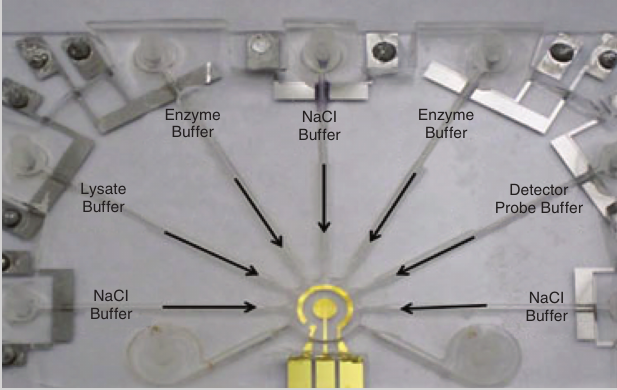Integrated Microfluidic Systems for Molecular Diagnostics
By Mandy L. Y. Sin, Vincent Gau, Joseph C. Liao, and P. K. Wong
NOTE: This is an overview of the entire article, which appeared in the March 2013 issue of the IEEE Nanotechnology Magazine.
Click here to read the entire article.
The authors summarize this development as follows –
In this study, we demonstrated a universal electrode approach for microfluidics-based molecular biosensing. Using the universal electrode platform, all fundamental microfluidic operations, such as pumping, mixing, washing, enhancement, and sensing, can be performed for molecular diagnostics. The asymmetric micropump design is capable of generating a large volumetric flow rate that is an order of magnitude higher than that generated by conventional electrolytic micropumps. Furthermore, the valveless design dramatically simplifies the system’s complexity and cost, both of which are essential for point-of-care diagnostics. The ability to directly perform in situ mixing and enhancement on the sensor electrode further simplifies the system complexity. Since only electronic interfaces are required to implement the universal electrode approach, the bulky supporting equipment required in typical bioanalytical settings is eliminated, facilitating the implementation of microfluidics-based bioanalysis in resource-limited settings.

The configuration of the universal electrode array for implementing the electrochemical assay for bacterial 16S rRNA.
The particular target of this demonstration was more rapid diagnosis of urinary tract infections using bacterial 16S rRNA as a marker. The authors see this fully integrated system as being able to move microfluidics platforms from the lab bench to point-of-care settings such as physicians’ offices and emergency departments,facilitating diagnosis of infectious diseases.
The platform is a single self-assembled monolayer (SAM) on a chip using only electrode interfaces. The article describes the components of the biosensor, including electolytic pumps and sensing electrodes.
Operation of the biosensor was evaluated for pumping and mixing efficiency. The effectiveness of the platform was compared with assays performed manually.
ABOUT THE AUTHORS
Mandy L. Y. Sin (mandysin@stanford.edu) is with the Department of Aerospace and Mechanical Engineering, University of Arizona, Tucson, and with the Department of Urology, Stanford University, Palo Alto, California.
Vincent Gau (vgau@genefluidics.com) is with GeneFluidics, Inc., Irwindale, California.
Joseph C. Liao (jliao@stanford.edu) is with the Department of Urology, Stanford University, Palo Alto, California.
P. K. Wong (pak@email.arizona.edu) is with the Department of Aerospace and Mechanical Engineering, University of Arizona, Tucson.






